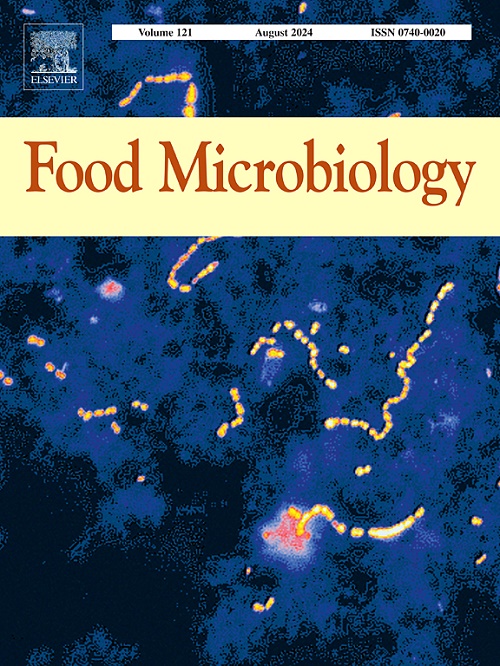优化红曲霉色素生产:从菌丝形态、基因表达和模拟海水发酵转录组分析的见解
IF 4.5
1区 农林科学
Q1 BIOTECHNOLOGY & APPLIED MICROBIOLOGY
引用次数: 0
摘要
红曲霉色素(Monascus色素,MPs)是红曲霉产生的次生代谢产物,受极端环境影响较大。本研究通过菌丝形态、基因表达和转录组学分析,探讨了MPs在模拟海水发酵(SSF)中的调控机制。与常规发酵(CF)相比,SSF发酵的细胞外黄色色素(EYPs)产量显著提高34.2%。4种EYPs的相对比例(Y1/Y2-Y4)和细胞内橙色色素与黄色色素的相对含量(O/Y)也显著差异(p <;0.05)改变。荧光倒置显微镜(FIM)和场发射扫描电镜(FE-SEM)观察结果显示,丝状体形态受到较好的调控,促进了丝状体中MPs的代谢和分泌。色素生物合成基因MpFasA2、MpFasB2、MpPKS5、mppB、mppC、mppD和mppE显著(p <;0.05)上调,而调控基因mppR1、mppR2显著上调(p <;0.05), SSF下调。转录组进一步揭示了两组(CF与SSF)之间的83个差异表达基因(deg),其中40个上调,43个下调。其中,与色素合成相关的聚酮合成酶基因和脂肪酸氧化降解途径在SSF中显著上调,促进了MPs的代谢。DNA复制通路的下调表明细胞生长和分化速度减慢,从而保持了MPs合成的有利状态。细胞壁组分的生物代谢相关途径和分泌相关途径也受到显著调控,加速了EYPs的跨膜转运。本研究可能为阐明红曲霉高渗透耐受性的响应机制提供线索。本文章由计算机程序翻译,如有差异,请以英文原文为准。
Optimizing Monascus pigment production: Insights from mycelial morphology, gene expression, and transcriptomic analysis in simulated seawater fermentation
Monascus pigments (MPs) are secondary metabolites produced by Monascus spp., which can be significantly influenced by the extreme environment. In this work, the regulatory mechanism of MPs in simulated seawater fermentation (SSF) were investigated following mycelial morphology, gene expression, and transcriptomic analysis. Yield of the extracellular yellow pigments (EYPs) was significantly increased by 34.2 % in SSF, compared with the conventional fermentation (CF). The relative proportion of four EYPs (Y1/Y2-Y4) and the relative content of intracellular orange pigments to yellow pigments (O/Y) were also significantly (p < 0.05) changed. Fluorescence inverted microscope (FIM) and field emission scanning electron microscope (FE-SEM) showed the mycelium morphology was regulated in better status to facilitate the metabolism and secretion of MPs in SSF. The pigment biosynthesis gene MpFasA2, MpFasB2, MpPKS5, mppB, mppC, mppD, and mppE were significantly (p < 0.05) up-regulated, whereas the regulatory genes mppR1, mppR2 were significantly (p < 0.05) down-regulated in SSF. Transcriptome further revealed 83 differentially expressed genes (DEGs) between the two groups (CF vs SSF), with 40 up-regulated and 43 down-regulated. Among them, polyketide synthase genes and fatty acid oxidative degradation pathways related to pigment synthesis were significantly up-regulated in SSF, which promoted the metabolism of MPs. The down-regulation of DNA replication pathway indicated a slowdown in cell growth and differentiation, which keeping a favorable state for MPs synthesis. Biometabolism-related pathways of cell wall component and secretion-related pathways were also significantly regulated to accelerate the transmembrane transport of EYPs. This study may provide clues to clarify the response mechanism of high osmotic tolerance of Monascus spp.
求助全文
通过发布文献求助,成功后即可免费获取论文全文。
去求助
来源期刊

Food microbiology
工程技术-生物工程与应用微生物
CiteScore
11.30
自引率
3.80%
发文量
179
审稿时长
44 days
期刊介绍:
Food Microbiology publishes original research articles, short communications, review papers, letters, news items and book reviews dealing with all aspects of the microbiology of foods. The editors aim to publish manuscripts of the highest quality which are both relevant and applicable to the broad field covered by the journal. Studies must be novel, have a clear connection to food microbiology, and be of general interest to the international community of food microbiologists. The editors make every effort to ensure rapid and fair reviews, resulting in timely publication of accepted manuscripts.
 求助内容:
求助内容: 应助结果提醒方式:
应助结果提醒方式:


